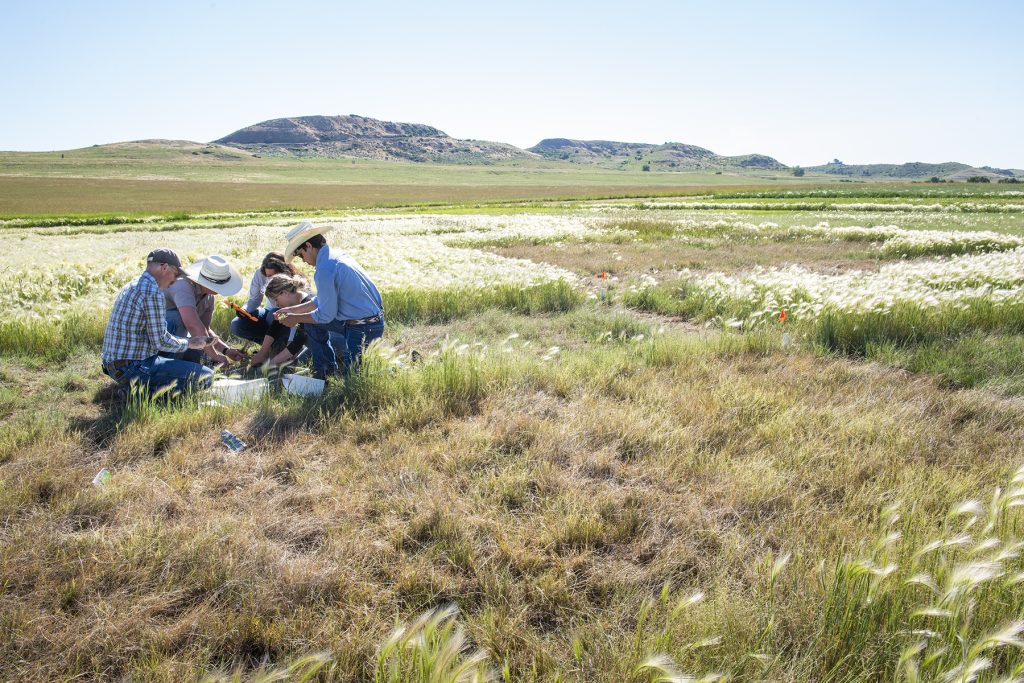

Wyoming’s new Institute for Managing Annual Grasses Invading Natural Ecosystems (IMAGINE) is on a mission.
A state-wide collaboration, IMAGINE’s purpose is to develop long-term strategies for invasive grass management on a landscape scale—while empowering local decision makers.
It all started with a simple question (or, perhaps, not so simple), posed to Wyoming ranchers and landowners, says Brian Mealor, director of IMAGINE. “What are some big issues that affect your agricultural operations, and how can we help?”
Getting rid of invasive grasses, like cheatgrass, medusahead and ventenata, was at the top of the list. The issue wasn’t new. Management and treatment efforts, led by various agencies and landowners, were already underway across the state.
Invasive annual grasses (IAGs) are more than an agricultural weed problem, Mealor says. Estimates suggest that more than 50 million acres of rangeland are impacted by cheatgrass and other invasive grasses in the western U.S. IAGs degrade grazing resources and wildlife habitat, as well as changing wildfire cycles.
A diverse partnership
Founded by a mix of public and private funding, IMAGINE is designed to expand research and monitoring of invasive annual grasses in conjunction with local control strategies and data collection.
The partnership includes a diverse group of organizations, including the University of Wyoming Agricultural Experiment Station, Wyoming weed and pest control districts, the Wyoming Game and Fish Department, and The Nature Conservancy. Other partners include the University of Wyoming Extension, Haub School of Environment and Natural Resources, and the Biodiversity Institute.
Embracing a new approach
It’s an unconventional model—and that’s why it works, says Slade Franklin, statewide weed and pest coordinator for the Wyoming Department of Agriculture.
IMAGINE targets informational gaps on IAGs by tapping into the strengths of all partners involved, including University researchers and “people on the ground who know what works.” In many ways, IMAGINE’s approach is a “reversal of duties, a reversal of knowledge sharing,” Franklin explains.
Mealor, who is also director of the Sheridan Research and Extension Center, agrees. Weed and pest district supervisors, for example, possess a wealth of local knowledge and are often the go-to resource for invasive species management in their counties. UW researchers can complement their work, and that of other IMAGINE partners, by adding a data collection and analysis component to their IAG management practices.
Creating a state-wide monitoring network
Ian Tator, statewide terrestrial habitat manager for Wyoming Game and Fish, says the vision for IMAGINE is “the same vision that we have at Game and Fish: a future where we develop the tools, resources and training to reduce the spread and coverage of IAGs in Wyoming.”
Currently, Tator says, collaborative efforts are largely focused on remotely sensed imagery and modeling for IAGs. “This groundbreaking approach will help us refine a Wyoming-based model that will be used to determine the scope of infestation and extent of coverage for IAGs.”
IMAGINE’s monitoring network is designed to help streamline data collection across the state, says Jaycie Arndt, IMAGINE coordinator and UW Extension educator. Monitoring, which began in three counties in 2021, focuses on identifying annual grass populations, assessing the effectiveness of herbicide treatments, and confirming the accuracy of remote sensing data.
The network has since expanded to include projects in seven counties across the state. The ultimate goal is to help facilitate “broader landscape-scale decisions based on results from different management techniques,” Arndt explains.
Serving communities
A successful toolkit for combatting invasives must consider socioeconomic wellbeing as well as ecosystem health. IMAGINE’s mission extends beyond environmental control of IAGs. Researchers are also working with stakeholders to study the socioeconomic impacts of invasives.
The Institute seeks to “better understand the economic impact of invasive plants, at the county level and up to the state level—and the benefits of controlling these species long term,” Mealor reports.
The Institute recently received a $500,000 gift from the Watt Foundation, matched by the state of Wyoming. The funding will further IMAGINE’s capacity to “serve an important role to the people of Wyoming by increasing our ability to protect high-quality rangelands and to restore rangelands degraded by invasive species,” says Mealor.
Successful research, management and prevention strategies targeted at IAGs will require ongoing landscape-level data collection and widespread collaboration. IMAGINE is currently putting together an advisory board, which will include landowners as well as representatives from various state and federal agencies.
A one-stop shop
One of the Institute’s long-term goals is to develop a “one-stop shop” for resources and reporting related to IAGs.
“We’ve laid the groundwork for a central data clearinghouse related to invasive grasses information,” Mealor reports. “We’d like to get to the point where landowners can report their own infestations and download data that are relevant.” Collaborators for this project will include the Wyoming Natural Diversity Database, Wyoming Geographic Information Science Center and others.
“IMAGINE has the capability of being a hub for data and information related to invasive annual grass management, not just for Wyoming, but for the entire Western region,” says Franklin.
Imagine that.
To learn more about IMAGINE, visit www.invasivegrasses.com or contact Brian Mealor at bamealor@uwyo.edu.




